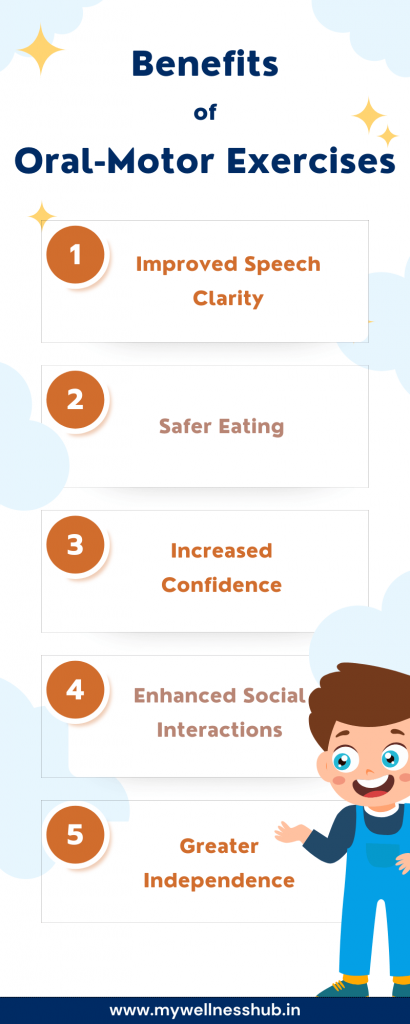Discover the Best Oral-Motor Exercises for Adults
Last Updated: May 16, 2024
Have you ever thought about how we manage to speak, eat, or even drink effortlessly? It’s all thanks to our oral-motor skills — a complex system that involves our lips, tongue, jaw, and throat working in perfect harmony. But what happens when this system doesn’t work as smoothly as it should? That’s where oral-motor exercises for adults come into play.
Oral-motor exercises are not just about improving speech; they are crucial for anyone facing challenges with speaking and swallowing. If you’ve ever struggled with slurred speech, difficulty chewing, or even swallowing safely, these exercises can be a game-changer. They’re designed to strengthen and coordinate the muscles in your mouth and throat, ensuring that every word and every bite is as effortless as it should be.
Understanding Oral-Motor Skills
What are Oral-Motor Skills?
Oral-motor skills are the abilities required to use and coordinate the muscles of the mouth, including the lips, tongue, cheeks, jaw, and palate. These skills are fundamental not just for speech but also for a variety of daily activities such as eating, drinking, and even facial expressions.
The Importance of Oral-Motor Exercises
Now, you might wonder why oral-motor exercises are a big deal. Simply put, these exercises are vital for anyone needing to maintain or improve the functionality of their oral muscles. Whether it’s recovering from a medical condition that affected your speech and swallowing or enhancing clarity in speech, oral-motor exercises provide the training needed to strengthen these muscles.
Regularly practicing these exercises can lead to noticeable improvements in speech clarity, making conversations more enjoyable and less stressful. For those with swallowing difficulties, these exercises can be life-changing, significantly reducing the risk of choking and making eating a safer, more pleasurable experience.
Who Needs Oral-Motor Exercises?
Identifying the Need
Have you ever noticed someone having a bit of trouble speaking clearly, or maybe they often complain about difficulties while eating? These might be signs that oral-motor exercises could help. Recognizing the need for these exercises is the first step toward improving one’s quality of life. Here are some symptoms and signs that might indicate a need for oral-motor exercises:
- Slurring of Speech: Difficulty in articulating words clearly can be a telltale sign.
- Swallowing Difficulties: Challenges with swallowing safely, which might include coughing or choking when eating.
- Drooling: Unintentional drooling can occur if the oral muscles aren’t coordinating properly.
- Reduced Oral Sensitivity: Less awareness of food or liquids in the mouth, leading to spills.
- Tongue Coordination Issues: Difficulty moving the tongue to the correct position for speaking or eating.
- Facial Muscle Weakness: Noticeable lack of control in the muscles of the face and mouth.
Conditions Benefited by Oral-Motor Exercises
Oral-motor exercises aren’t just beneficial for anyone; they are particularly crucial for individuals with certain medical conditions. These exercises can bring significant improvements in daily life for those dealing with the following:
- Dysarthria: This condition affects the muscles you use for speaking, often making your speech slow, slurred, or soft. Oral-motor exercises can help strengthen these muscles and improve speech clarity.
- Dysphagia: Difficulty in swallowing can be frightening and can drastically affect one’s life. These exercises help improve the control of muscles involved in swallowing.
- Neurological Issues: Many neurological conditions can impair oral-motor function. Regular exercises help maintain muscle tone and function, which can be essential for those with conditions like Parkinson’s disease or after a stroke.
These exercises are not just about rehabilitation; they’re about empowerment. They enable individuals to communicate more effectively and enjoy a meal without anxiety. Imagine the relief and joy that come from being able to express oneself clearly or share a meal with loved ones without worry!
Symptoms Indicating the Need for Oral-Motor Exercises
| Symptom | Possible Cause | Exercise Recommendation |
|---|---|---|
| Slurring of Speech | Weakness in tongue and lip muscles | Lip pops, tongue stretches |
| Swallowing Difficulties | Poor control of throat and mouth muscles | Cheek puffs, swallowing exercises |
| Drooling | Reduced oral sensitivity and control | Lip closure exercises, chin tucks |
| Tongue Coordination Issues | Inadequate tongue movement | Tongue lateralization, tongue elevation |
| Facial Muscle Weakness | Decreased muscle tone | Smiles, cheek puffs with resistance |
| Reduced Oral Sensitivity | Neurological issues, lack of awareness | Sensory stimulation exercises with textures |
| Chewing Difficulties | Jaw muscle weakness | Jaw exercises, such as wide jaw stretches |
| Frequent Choking | Ineffective swallow reflex | Swallowing drills, sip and puff exercises |
| Difficulty Articulating Sounds | Limited range of motion in articulators | Articulation drills, phonetic placement exercises |
Core Oral-Motor Exercises
Embarking on oral-motor exercises can be a transformative journey toward better speech and eating capabilities. Here, we’ll guide you through some simple yet effective exercises divided into three main categories: Lip and Cheek Exercises, Jaw and Tongue Exercises, and Palate Exercises. These can be practiced from the comfort of your home and integrated into your daily routine.
Lip and Cheek Exercises
- Lip Pops
- Press your lips together tightly and then release them quickly, creating a popping sound. Repeat this 10 times to strengthen your lip muscles.
- Cheek Puffs
- Fill your cheeks with air and hold for three seconds. Transfer the air from one cheek to the other, then release. This exercise helps improve the control and flexibility of your cheek muscles.
- Smiles
- Simply smile as wide as you can, hold for a few seconds, and relax. Repeat 10 times. This not only strengthens the lips but also uplifts your mood!
Read more: Oral Motor Exercises: Tongue Exercises for Confident Speech
Jaw and Tongue Exercises
- Jaw Opening and Closing
- Open your jaw as wide as comfortable, hold for a few seconds, and slowly close it. Do this 10 times to enhance jaw mobility and strength.
- Tongue Movements
- Stick out your tongue as far as you can and try to reach your nose and then your chin. Hold each stretch for a few seconds. This enhances tongue flexibility and range of motion.
Also Read: Oral Motor Exercises: Jaw Exercises for Effective Communication
Palate Exercises
- Straw Blowing
- Use a straw to blow bubbles into a glass of water. This helps strengthen the muscles of your mouth and throat.
- Cheek Puffing with Resistance
- Puff out both cheeks with air, and use your hands to gently press against them to create resistance. Hold this for a few seconds before releasing. Repeat 5 times.
Also read Oral Motor Exercises: Improve Soft Palate Sensations.
These exercises are not only practical but can also be quite enjoyable. They serve as a means to regain control over vital functions, enhancing your ability to communicate and enjoy meals. By incorporating these exercises into your daily routine, you can significantly improve the coordination and strength of your oral muscles.
Comparison of Oral-Motor Exercises
| Exercise Type | Difficulty Level | Targeted Outcome |
|---|---|---|
| Lip Pops | Beginner | Strengthens lip muscles, improves speech articulation |
| Cheek Puffs | Beginner | Enhances cheek muscle control, aids in chewing and speech |
| Smiles | Beginner | Improves facial muscle tone and expression control |
| Jaw Opening and Closing | Intermediate | Increases jaw mobility, helps with chewing and speech |
| Tongue Movements | Intermediate | Enhances tongue flexibility, improves speech and swallowing |
| Straw Blowing | Intermediate | Strengthens mouth and throat muscles, improves breath control |
| Cheek Puffing with Resistance | Advanced | Builds cheek muscle endurance, enhances speech clarity |
| Tongue Lateralization | Advanced | Improves the ability to move tongue side to side, essential for speech sounds |
| Tongue Elevation | Advanced | Increases tongue strength, important for swallowing and clear speech |
How to Perform Oral-Motor Exercises
Integrating oral-motor exercises into your daily routine can be simpler than you might think, and doing so effectively can greatly enhance their benefits. Here’s how you can set a routine and use techniques that ensure you get the most out of these exercises.
Setting a Routine
Consistency is key when it comes to any form of exercise, and oral-motor exercises are no exception. Here are a few tips to help you establish a routine:
- Frequency: Aim to perform these exercises at least three times a day – morning, midday, and night. This helps maintain muscle tone and coordination.
- Duration: Each session doesn’t need to be long. Even five to ten minutes can be sufficient if done properly and consistently.
- Integration: Incorporate these exercises into your daily activities. For instance, practice your lip and cheek exercises while watching TV or do tongue movements during your morning routine.
Techniques for Effective Practice
To maximize the effectiveness of your oral-motor exercises, consider these techniques:
- Use a Mirror: Performing exercises in front of a mirror can help you ensure you are doing them correctly. It allows you to see and adjust your movements in real time, enhancing the effectiveness of each exercise.
- Video Demonstrations: Sometimes, following along with a video can make the exercises easier to understand and perform. Look for reliable resources online or specific videos recommended by your speech-language therapist.
- Consistency is Crucial: Regular practice is essential for progress. Make these exercises a non-negotiable part of your daily routine, just like brushing your teeth.
- Record Your Progress: Keeping a log of your exercises and any improvements you notice can be motivating. It also helps your therapist track your progress and make adjustments to your routine as needed.
By setting a solid routine and using these techniques, you’ll be better equipped to improve your oral-motor skills effectively. Remember, these exercises are not just about repetition; they’re about making gradual improvements in your ability to speak and swallow. Patience and persistence will be your best allies on this journey.
Benefits of Oral-Motor Exercises

When we think about the rewards of regular physical exercise, improved strength and health immediately come to mind. Similarly, oral-motor exercises offer vital benefits, particularly improving speech and eating abilities, which in turn enhance overall quality of life. Let’s explore how these targeted exercises can make daily living not only easier but also more enjoyable.
Speech and Eating Improvements
- Speech Clarity: One of the most noticeable impacts of oral-motor exercises is the improvement in speech clarity. These exercises strengthen the muscles involved in speech production, allowing for clearer and more precise pronunciation. For anyone who has struggled with slurring or stuttering, this can be a significant boost to daily interactions.
- Safer, More Effective Eating: Beyond speech, these exercises enhance the safety and efficiency of swallowing. Strengthening and coordinating the muscles of the mouth and throat helps prevent choking hazards and makes eating a more pleasant and less stressful experience. For many, it reopens the door to enjoy a wider variety of foods, particularly those that were previously too difficult to manage.
Enhanced Confidence and Quality of Life
- Boosted Self-Esteem: Improved communication capabilities directly contribute to heightened self-esteem and confidence. Being able to express oneself clearly is empowering and can open up new social, professional, and personal opportunities.
- Increased Independence: For many adults, especially those recovering from a stroke or dealing with conditions like Parkinson’s disease, oral-motor exercises can be a key component in regaining independence. The ability to speak more clearly and eat safely without assistance can significantly improve an individual’s sense of autonomy and quality of life.
- Emotional and Psychological Benefits: Lastly, the psychological uplift from being able to communicate more effectively cannot be overstated. For someone who has felt isolated by their speech or swallowing difficulties, these improvements can mean a happier, more social lifestyle.
Oral-motor exercises might seem like a small part of one’s daily routine, but their impact is profound. Whether it’s sharing a meal with family without difficulties or chatting confidently with friends, the benefits of these exercises enrich everyday life.
Seeking Professional Guidance
While exploring and practicing oral-motor exercises on your own can lead to significant improvements, there comes a time when professional guidance is crucial. Understanding when and how to seek this help can make all the difference in your journey toward better speech and swallowing capabilities.
When to Consult a Speech-Language Therapist
It’s essential to recognize the signs that indicate the need for a professional assessment. If you or your loved one is not seeing improvements or the oral-motor challenges interfere significantly with daily life, it’s time to consult a speech-language therapist. These professionals can provide a comprehensive evaluation and tailor a set of exercises specifically designed for your unique needs.
A speech-language therapist will also monitor progress and adjust exercises as needed to ensure the most effective treatment. This personalized attention can accelerate improvements and help overcome any specific challenges you might face.
Support Resources
In addition to professional help, numerous support resources are available to assist individuals dealing with speech and swallowing difficulties. These might include:
- Online Forums and Support Groups: Connecting with others facing similar challenges can provide emotional support and practical advice.
- Educational Materials: Many reliable health websites offer tutorials, videos, and articles that can help you understand and manage your condition better.
- Local Health Services: Check with your local health department for resources and programs available in your community.
While specific recommendations or services, such as those offered by Wellness Hub, are available, it’s crucial to start by consulting with a qualified professional who can guide you to the right resources based on your individual needs.
Conclusion
Discovering and practicing oral-motor exercises can greatly improve your speech and eating. These simple exercises strengthen your mouth muscles, making it easier to talk clearly and enjoy your meals safely. It’s amazing how something as straightforward as practicing a few exercises daily can enhance your life.
We encourage you to start these exercises today. Begin with easy ones like lip pops or cheek puffs and build up as you get comfortable. Keep at it, and you’ll see improvements in no time. Remember, if you ever need help or feel stuck, professional advice is just a conversation away. Here’s to a clearer voice and safer eating, one step at a time!
Frequently Asked Questions:
1. What are oral-motor exercises?
Oral-motor exercises are specialized exercises aimed at improving the strength, coordination, and functioning of the muscles in the mouth and throat. These exercises are crucial for individuals having difficulties with speech and swallowing.
2. Who needs oral-motor exercises?
Individuals who experience slurring of speech, swallowing difficulties, drooling, or other signs of oral muscle weakness may benefit from oral-motor exercises. They are particularly helpful for adults with conditions like Dysarthria, Dysphagia, and other neurological issues.
3. How often should I perform oral-motor exercises?
It’s recommended to perform oral-motor exercises three times a day — morning, midday, and evening. Each session can last about 5 to 10 minutes, depending on the exercises and individual capabilities.
4. Can oral-motor exercises improve speech clarity?
Yes, regular practice of oral-motor exercises can significantly improve speech clarity by strengthening the muscles used in speech production, which helps in articulating words more clearly and reduces speech impediments.
5. Are oral-motor exercises helpful for eating and swallowing?
Absolutely! Oral-motor exercises enhance the control and coordination of mouth and throat muscles, making eating and swallowing safer and more efficient. This can greatly reduce the risk of choking and make mealtime more enjoyable.
6. What should I do if I don’t notice improvement from oral-motor exercises?
If you do not notice any improvement or if the exercises become too challenging, it’s important to consult a speech-language therapist. A professional can assess your situation and tailor a specific set of exercises to meet your needs, ensuring you receive the most effective treatment.
7. Where can I find reliable resources or support for oral-motor exercises?
Many online forums, health websites, and local health services offer support and resources for people practicing oral-motor exercises. Connecting with a speech-language therapist can also provide you with personalized guidance and additional resources.
8. Can anyone perform oral-motor exercises, or do I need special equipment?
Oral-motor exercises do not typically require any special equipment and can be performed by most people. Simple exercises like lip pops, cheek puffs, and tongue movements can be done anywhere and at any time. However, specific conditions may require specialized tools or supervision from a speech-language therapist.
9. How do I know if I’m doing oral-motor exercises correctly?
Performing oral-motor exercises in front of a mirror can help you see and correct your movements. Additionally, video demonstrations by professionals can provide guidance. For personalized feedback and assurance, consulting with a speech-language therapist is the best approach to ensure you are performing the exercises correctly.
10. What are the long-term benefits of consistent oral-motor exercise practice?
Consistent practice of oral-motor exercises can lead to long-term improvements in speech clarity, swallowing safety, and overall oral muscle health. Over time, these benefits contribute to increased confidence in social situations, enhanced quality of life, and greater independence, especially for individuals recovering from medical conditions affecting speech and swallowing.
About the Author:
Anuradha Karanam
Speech-language pathologist (7+ years of experience)
Anuradha Karanam is a skilled speech-language pathologist with over 6 years of experience. Fluent in Tamil, Telugu, Hindi, and English, she specializes in parent counseling, speech sound disorders, fluency assessment, and speech-language evaluations. Anuradha excels at working with children with developmental disorders, offering creative and effective therapy programs. Currently, at Wellness Hub, she holds a BASLP degree and is registered with the RCI (CRR No A85500). Her patience, ambition, and dedication make her a trusted expert in her field.
Connect with Anuradha to learn more about how she can help you or your loved one find their voice.
Book your Free Consultation Today
Parent/Caregiver Info:
Client’s Details:
* Error Message









